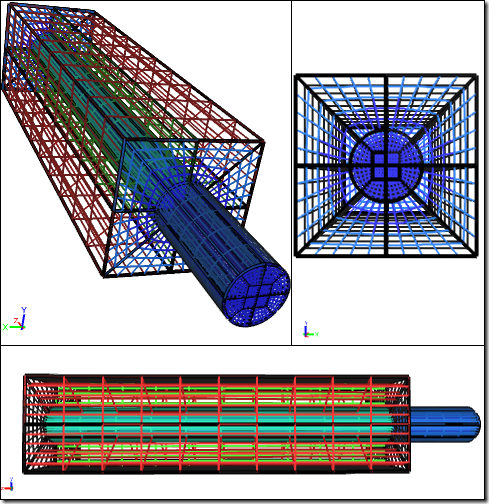
March 2011
I know what you are thinking - that news on the next major release of Caedium (V3) has been scarce, so how about I offer up a sneak peek of one new feature this month? Rest assured that there will be plenty of other exciting new features too. Also check out the teasers for my recent blog posts.
 Sneak Peek of a Multi-Block Structured Mesh Created in Caedium v3
Sneak Peek of a Multi-Block Structured Mesh Created in Caedium v3
Caedium v3 Sneak Peek: Non-Manifold Geometry
A major new feature of the next Caedium release will be the ability to create non-manifold geometry. This means that two volumes can share a single face (zero-thickness membrane). Profound consequences for your CFD simulations await that will allow you to:
- Create a set of interconnected volumes each with 6 faces such that Caedium's structured meshing algorithm can then generate high quality hexahedral elements, which is also known as multi-block meshing. Often you will find that hexahedral meshes will provide improved accuracy over tetrahedral meshes.
- Assign different initial conditions to different volumes within a flow domain to speedup the convergence rate of a simulation.
- Create zero-thickness (or double sided) walls to avoid having to resolve extremely thin faces and wasting mesh elements.
Stay tuned for more sneak peeks as we finalize the release. And before you ask, no I don't yet have a provisional release date, but I'm working on it.
Blog
Below are teasers for my latest blog posts.
Design for Simulation then Manufacture
Performing a Computational Fluid Dynamics (CFD) simulation on a detailed CAD model is no fun and, more importantly, it is often near useless. Why? Because given that an engineer has committed considerable time and effort to produce a detailed model ready for manufacture, I doubt they will be happy making additional model changes and the extensive rework that it will entail in response to the CFD results. Design for Manufacture (DFM) has been a successful and widely adopted strategy to reduce product manufacturing costs (bottom line improvement). However, such a focus on manufacturability in isolation from functional analysis and optimization (e.g., we can make a cheap airplane, but will it fly?) is missing a huge opportunity to provide enhanced functional capabilities for which customers are willing to pay a premium (top line improvement).
Rather than the Design for Manufacture mantra, I suggest a better approach is to adopt Design for Simulation, then Manufacture, where simulation could be any combination of stress analysis, CFD, etc. Read more >>
CFD Bid Modeling
Kenneth Wong's Virtual Desktop over at Desktop Engineering ran an interview in May 2010 with Blake Courter and Jeff Waters from SpaceClaim. Blake and Jeff suggested that adding a customized 3D model to an engineering contract bid significantly improved the bid's chance of winning a contract. They coined the term Bid Modeling to describe this process. I think this same idea can be extended to Computational Fluid Dynamics (CFD) consultancy contract bidding - let's call it CFD Bid Modeling. Read more >>
